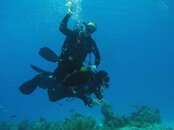- Messages
- 99,844
- Reaction score
- 102,783
- Location
- On the Fun Side of Trump's Wall
- # of dives
- 2500 - 4999
Sometimes single-file is necessary ... diving a wall, for example. Shoulder-to-shoulder doesn't work well on a wall, because one person will always be too far from the wall to really look at what's on it. What we do instead is dive at slightly different depths ... a few feet difference ... top person leading by about a body-length. Since the person above is in front, the person below can look up and see their buddy easily. The person below is also easily visible to the above buddy, who only has to look down and a bit back. Also that way the bubbles from the person below don't interfere with the buddy. It's also easy to signal each other if one of you finds something interesting to share ... especially in darker water where light signals are effective ...
... Bob (Grateful Diver)
... Bob (Grateful Diver)




